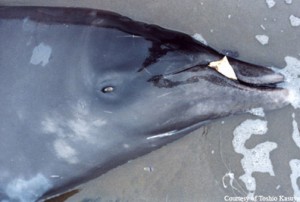
Three rarely seen whales beached on Alaska’s coast last year, and NOAA Fisheries is investigating whether human activity contributed to the strandings.
The Stejneger’s beaked whales beached last fall: one on St. Lawrence Island and two in Valdez. Neither of those places are where Stejneger’s are usually found, and each animal showed indications of trauma.
“They had bubbles of air within the blood vessels,” Dr. Kathy Burek Huntington, from the Alaska Veterinary Pathologist Service, said. “And this is true in all the cases—the animals in Valdez and also the animal up in the St. Lawrence Island area. You know, this is just a classic lesion that you see when there’s an animal that suffered from barotrauma.”
Huntington performed the necropsies on the whales in Valdez and said barotrauma is like the bends in humans— often caused by rising too quickly to the surface from a deep dive. But Stejneger’s are built for deep dives. They’re usually found over a half mile below the water.
“They should have certain behaviors that should allow them to avoid that situation if they’re acting normally,” Huntington said.
Loud noises can send the whales rocketing to the surface, and seismic activity can also damage barriers within the whales’ bodies between gas-filled areas and the bloodstream. Both situations can cause trauma. “For example,” Huntington explains, “if there’s blasting going on in an area, underwater blasting, that can create this kind of thing. It’s thought that really high intensity sonar is another possibility. “
Beaked whales’ tendency for deep dives makes their presence in the shallow waters of the Bering Strait Region and Valdez unusual. Aleria Jensen, the NOAA Fisheries Marine Mammal Stranding Coordinator for the Alaska Region, said beachings occur for many reasons, like disease, entanglement, and ship collisions.
So far, she said there’s no evidence of any of those in these whales.
“So it leads us back to the gas bubbles pointing to some kind of acoustic trauma, so we want to see what was going on in the area during that time,” Jensen said.
NOAA Fisheries is investigating the cause of the strandings and if noise from human activity contributed.
Huntington said there were reports of seismic activity in Valdez in the area of the beaching, but the investigation is ongoing.
(Editor’s note: This article originally stated Dr. Kathy Burek Huntington performed the necropsies on the whales. Dr. Huntington performed the necropsies on the two whales in Valdez. Gay Sheffield with the University of Alaska Fairbanks Marine Advisory Program performed the necropsy on the whale on St. Lawrence Island with support from the community of Gambell.)
